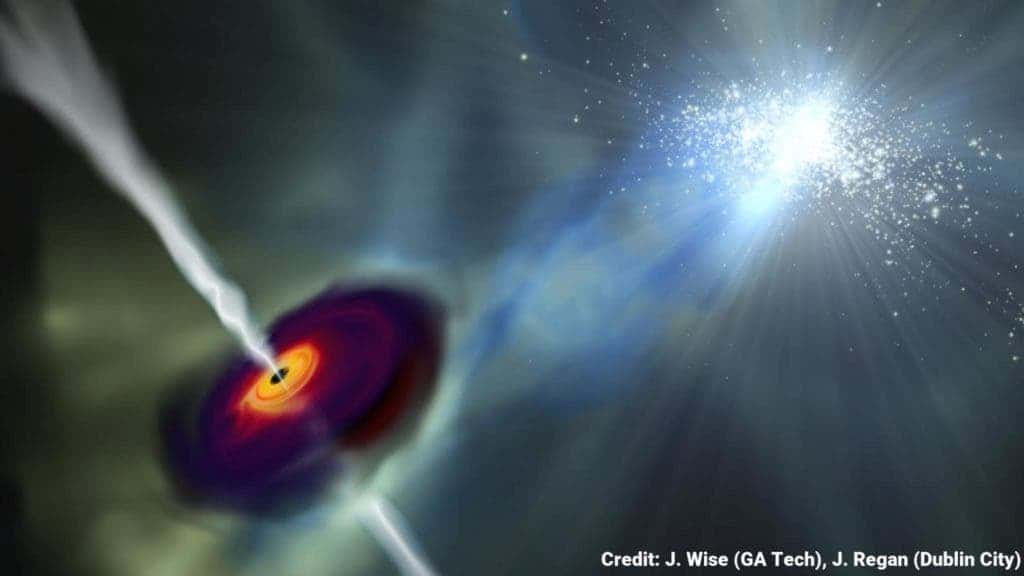The answer to an astronomical conundrum might be more than most scientists bargained for. A model that attempts to explain how supermassive black holes formed while the Universe was still in its infancy suggests some galaxies had to sacrifice their stellar forming role after being zapped with copious amounts of radiation from another neighboring galaxy. All that lots of matter then collapsed to directly form a supermassive black hole.

Previously, scientists established supermassive black holes, which typically have masses several million to even billions of solar masses, were already present in the Universe despite it was less than 800 million years old. Though virtually every galaxy has a supermassive black hole right at its center, there’s much we don’t understand about their role and how they formed.
Most black holes are birthed after a massive star run out of fuel and die spectacularly in a supernova explosion. When this happens, immense amounts of energy and matter are flung into outer space leaving behind only the core which eventually collapses under its own weight. Once a black hole is born, it immediately starts doing what it’s best at: sucking more matter and energy.
Knowing this, we can imagine that supermassive black holes start out small and then gradually become more massive by ingesting more dust, gas, hamburgers or whatever comes across the stellar-grade black hole’s insatiable appetite. Alternatively, multiple black holes can merge.
However, this is only one side of the picture. The truth is that a black hole isn’t an infinite funnel and there’s only so much matter and energy it can take up at once. For instance, when gas hurls towards a block hole attracted by its massive gravity it heats up following friction with other molecules and as a result of the strong gravitational field. This makes the hot gas emit strong radiation which can couple with infalling gas to exert pressure, blocking further gas infall.
In other words, you can’t spoon-feed a black hole until it grows into a monstrous beast millions of times more massive than our sun. But the fact remains that supermassive black holes have been around since the early days of the Universe, and we need an explanation.
Peter Johansson from the University of Helsinki, along with international colleagues, thinks he may have a satisfying answer. His team made a simulated model to see what conditions could lead to supermassive black hole formation in the early Universe.
Galactic sacrifice
The model assumes, based on previous work, that very large clouds of gas with masses 10,000 up to 100,000 solar masses can collapse directly to seed a supermassive black hole in certain conditions. Namely, a prime prerequisite is that the gas cooling must be inefficient otherwise the cloud would fragment to birth a star. Some 800 million years ago, the only way astrophysicists think this might have happened is if the gas was cooled to low temperatures by emissions from molecular hydrogen.
According to the model, such circumstances can be replicated in a rather unorthodox situation when two nearby galaxies are about to simultaneously form. Just at the right time, a burst of radiation from the first galaxy hitting the second can break molecular hydrogen (H2) into atomic hydrogen. And if that wasn’t rare enough, other conditions had to be met such as the radiation-emitting galaxy having to be a certain size and a certain distance away from the neutered galaxy which by now is unable to fulfill its stellar nursery role.
“The nearby galaxy can’t be too close, or too far away, and like the Goldilocks principle, too hot or too cold,” said study co-author John Wise, an associate astrophysics professor at Georgia Tech.
“The collapse of the galaxy and the formation of a million-solar-mass black hole takes 100,000 years—a blip in cosmic time,” said co-author Zoltan Haiman, an astronomy professor at Columbia University. “A few hundred-million years later, it has grown into a billion-solar-mass supermassive black hole. This is much faster than we expected.”
Understanding how supermassive black hole is of the utmost importance if we’re to unravel other secrets. Already, the team is planning some follow-up research and have an idea to study whether the merger of millions of black holes in ancient times could have also led to the formation of supermassive black holes.
Findings appeared in the journal Nature Astronomy.






